Exploring Corporate Taxation, Deductions, and the Income Tax Act
VerifiedAdded on 2023/06/03
|7
|1830
|398
Report
AI Summary
This report provides a comprehensive overview of corporate taxation, beginning with an explanation of the 'badges of trade' used to determine if an activity constitutes trading for tax purposes, referencing relevant legal cases. It then differentiates between allowable and non-allowable deductions under the Income Tax Act, listing various examples of each. Finally, the report examines the Income Tax Act 1995, focusing on corporate tax regulations in Mauritius, including the taxability of trusts, the concept of protected cell companies, and the criteria for determining tax residency. The analysis incorporates references to relevant sections of the Act and academic literature, concluding with a summary of the key concepts discussed.
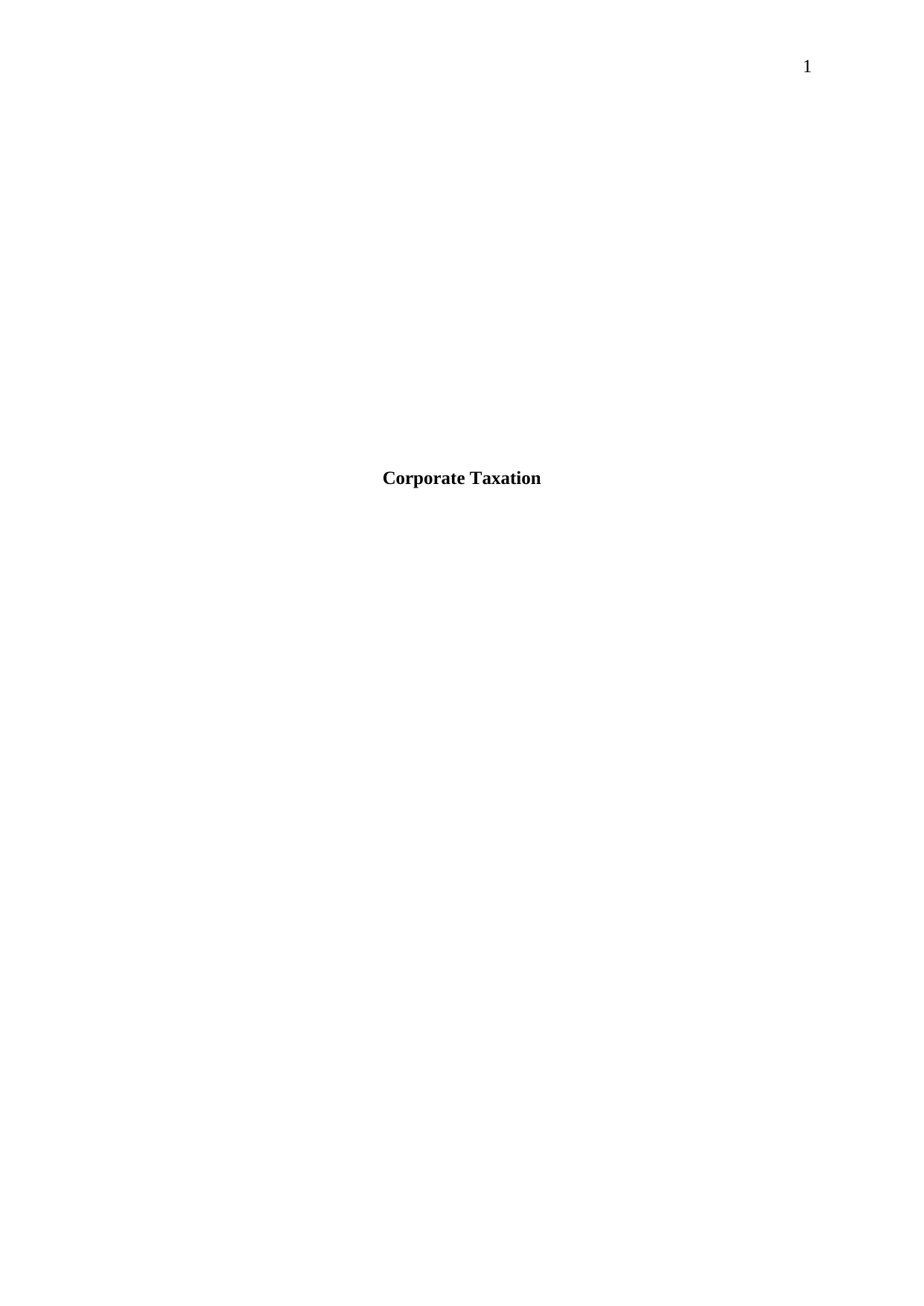
1
Corporate Taxation
Corporate Taxation
Paraphrase This Document
Need a fresh take? Get an instant paraphrase of this document with our AI Paraphraser
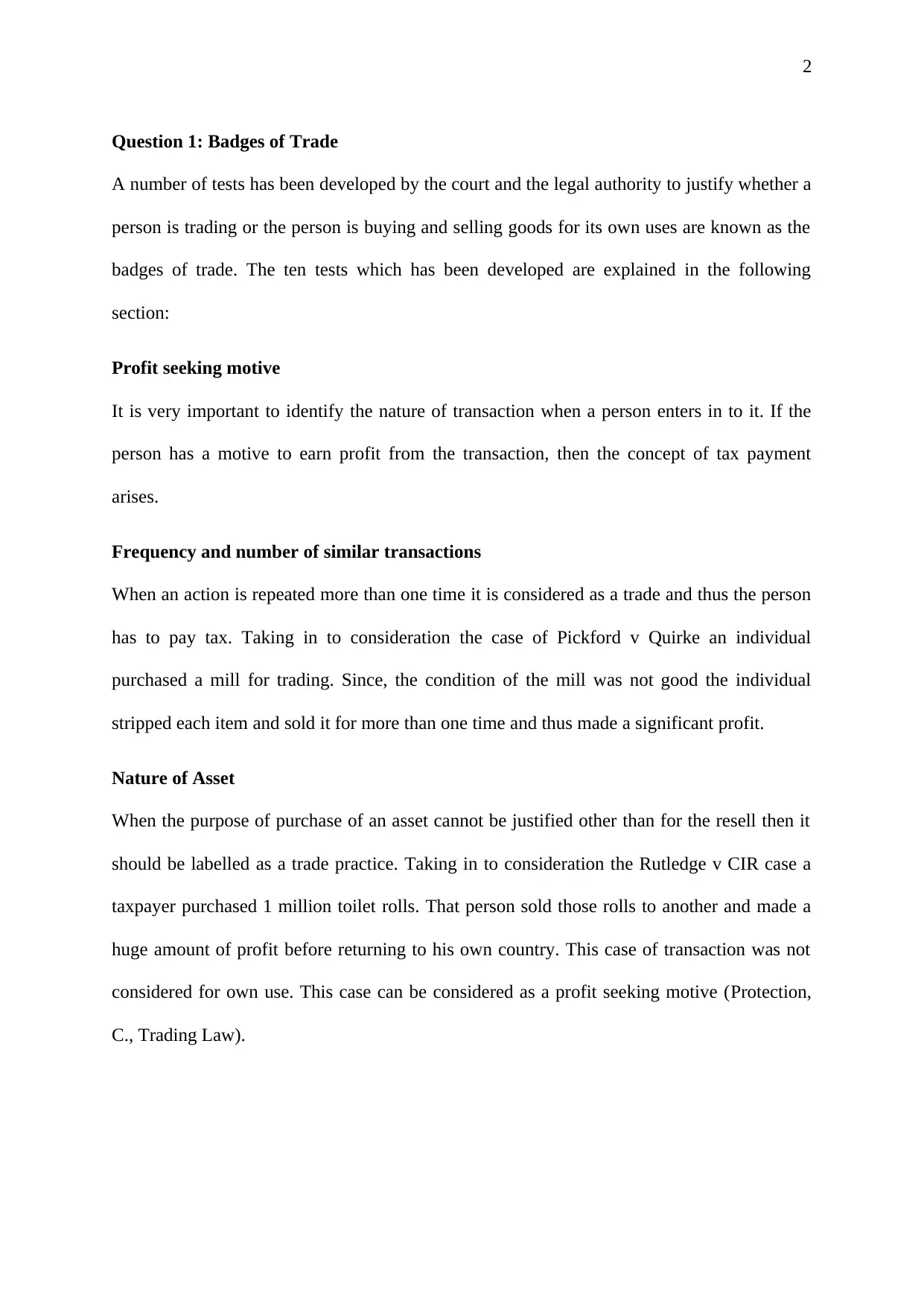
2
Question 1: Badges of Trade
A number of tests has been developed by the court and the legal authority to justify whether a
person is trading or the person is buying and selling goods for its own uses are known as the
badges of trade. The ten tests which has been developed are explained in the following
section:
Profit seeking motive
It is very important to identify the nature of transaction when a person enters in to it. If the
person has a motive to earn profit from the transaction, then the concept of tax payment
arises.
Frequency and number of similar transactions
When an action is repeated more than one time it is considered as a trade and thus the person
has to pay tax. Taking in to consideration the case of Pickford v Quirke an individual
purchased a mill for trading. Since, the condition of the mill was not good the individual
stripped each item and sold it for more than one time and thus made a significant profit.
Nature of Asset
When the purpose of purchase of an asset cannot be justified other than for the resell then it
should be labelled as a trade practice. Taking in to consideration the Rutledge v CIR case a
taxpayer purchased 1 million toilet rolls. That person sold those rolls to another and made a
huge amount of profit before returning to his own country. This case of transaction was not
considered for own use. This case can be considered as a profit seeking motive (Protection,
C., Trading Law).
Question 1: Badges of Trade
A number of tests has been developed by the court and the legal authority to justify whether a
person is trading or the person is buying and selling goods for its own uses are known as the
badges of trade. The ten tests which has been developed are explained in the following
section:
Profit seeking motive
It is very important to identify the nature of transaction when a person enters in to it. If the
person has a motive to earn profit from the transaction, then the concept of tax payment
arises.
Frequency and number of similar transactions
When an action is repeated more than one time it is considered as a trade and thus the person
has to pay tax. Taking in to consideration the case of Pickford v Quirke an individual
purchased a mill for trading. Since, the condition of the mill was not good the individual
stripped each item and sold it for more than one time and thus made a significant profit.
Nature of Asset
When the purpose of purchase of an asset cannot be justified other than for the resell then it
should be labelled as a trade practice. Taking in to consideration the Rutledge v CIR case a
taxpayer purchased 1 million toilet rolls. That person sold those rolls to another and made a
huge amount of profit before returning to his own country. This case of transaction was not
considered for own use. This case can be considered as a profit seeking motive (Protection,
C., Trading Law).
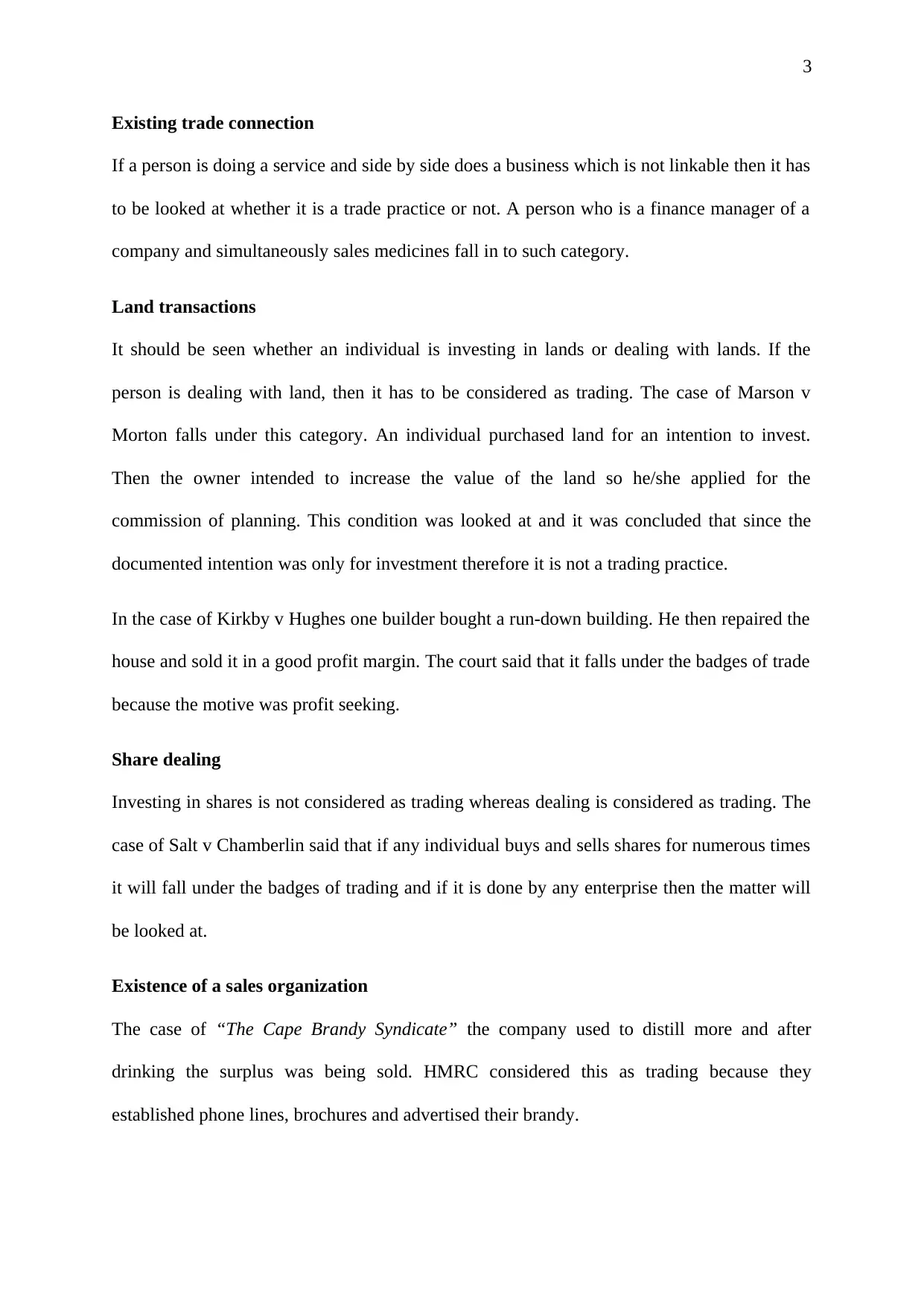
3
Existing trade connection
If a person is doing a service and side by side does a business which is not linkable then it has
to be looked at whether it is a trade practice or not. A person who is a finance manager of a
company and simultaneously sales medicines fall in to such category.
Land transactions
It should be seen whether an individual is investing in lands or dealing with lands. If the
person is dealing with land, then it has to be considered as trading. The case of Marson v
Morton falls under this category. An individual purchased land for an intention to invest.
Then the owner intended to increase the value of the land so he/she applied for the
commission of planning. This condition was looked at and it was concluded that since the
documented intention was only for investment therefore it is not a trading practice.
In the case of Kirkby v Hughes one builder bought a run-down building. He then repaired the
house and sold it in a good profit margin. The court said that it falls under the badges of trade
because the motive was profit seeking.
Share dealing
Investing in shares is not considered as trading whereas dealing is considered as trading. The
case of Salt v Chamberlin said that if any individual buys and sells shares for numerous times
it will fall under the badges of trading and if it is done by any enterprise then the matter will
be looked at.
Existence of a sales organization
The case of “The Cape Brandy Syndicate” the company used to distill more and after
drinking the surplus was being sold. HMRC considered this as trading because they
established phone lines, brochures and advertised their brandy.
Existing trade connection
If a person is doing a service and side by side does a business which is not linkable then it has
to be looked at whether it is a trade practice or not. A person who is a finance manager of a
company and simultaneously sales medicines fall in to such category.
Land transactions
It should be seen whether an individual is investing in lands or dealing with lands. If the
person is dealing with land, then it has to be considered as trading. The case of Marson v
Morton falls under this category. An individual purchased land for an intention to invest.
Then the owner intended to increase the value of the land so he/she applied for the
commission of planning. This condition was looked at and it was concluded that since the
documented intention was only for investment therefore it is not a trading practice.
In the case of Kirkby v Hughes one builder bought a run-down building. He then repaired the
house and sold it in a good profit margin. The court said that it falls under the badges of trade
because the motive was profit seeking.
Share dealing
Investing in shares is not considered as trading whereas dealing is considered as trading. The
case of Salt v Chamberlin said that if any individual buys and sells shares for numerous times
it will fall under the badges of trading and if it is done by any enterprise then the matter will
be looked at.
Existence of a sales organization
The case of “The Cape Brandy Syndicate” the company used to distill more and after
drinking the surplus was being sold. HMRC considered this as trading because they
established phone lines, brochures and advertised their brandy.
⊘ This is a preview!⊘
Do you want full access?
Subscribe today to unlock all pages.

Trusted by 1+ million students worldwide
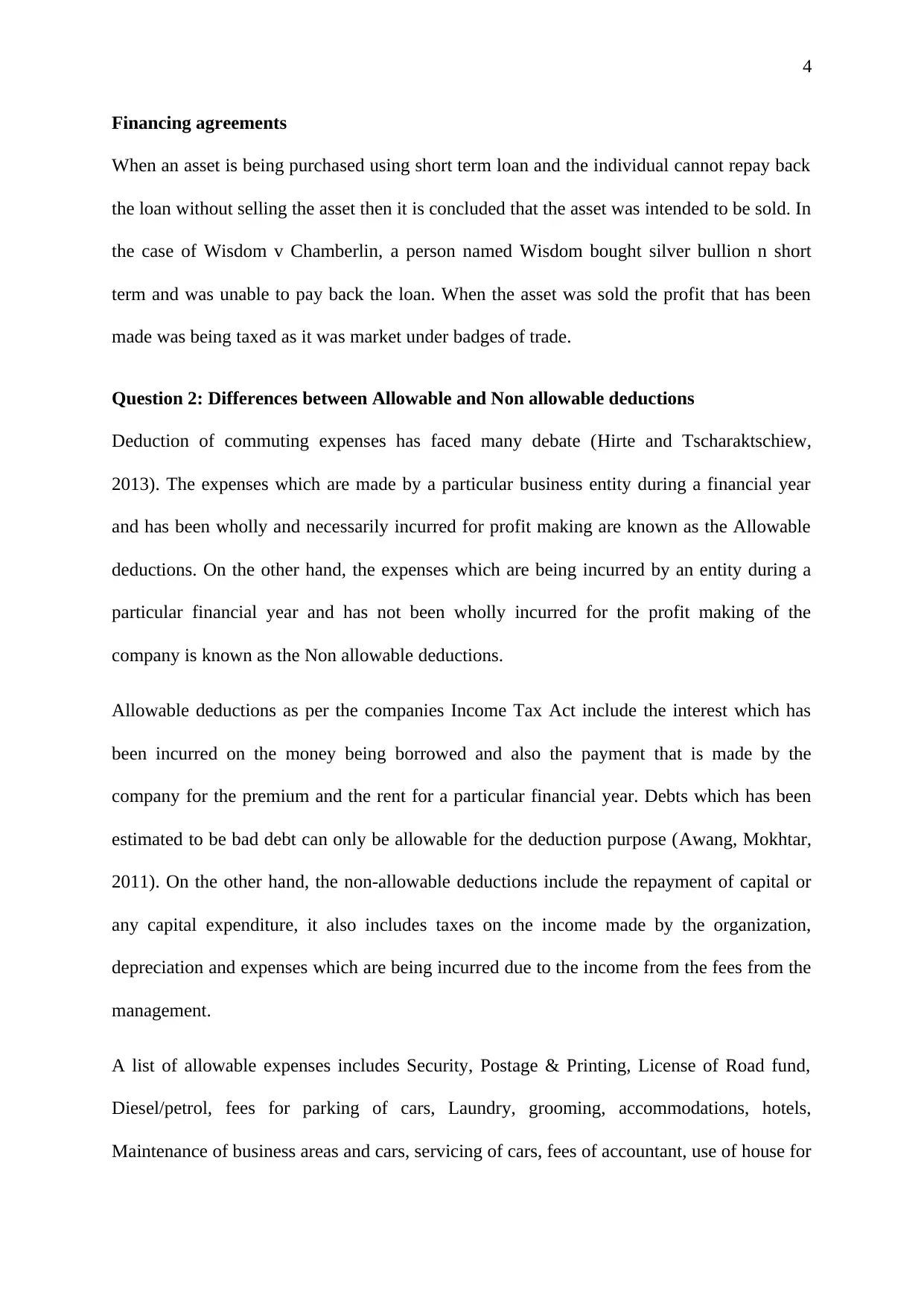
4
Financing agreements
When an asset is being purchased using short term loan and the individual cannot repay back
the loan without selling the asset then it is concluded that the asset was intended to be sold. In
the case of Wisdom v Chamberlin, a person named Wisdom bought silver bullion n short
term and was unable to pay back the loan. When the asset was sold the profit that has been
made was being taxed as it was market under badges of trade.
Question 2: Differences between Allowable and Non allowable deductions
Deduction of commuting expenses has faced many debate (Hirte and Tscharaktschiew,
2013). The expenses which are made by a particular business entity during a financial year
and has been wholly and necessarily incurred for profit making are known as the Allowable
deductions. On the other hand, the expenses which are being incurred by an entity during a
particular financial year and has not been wholly incurred for the profit making of the
company is known as the Non allowable deductions.
Allowable deductions as per the companies Income Tax Act include the interest which has
been incurred on the money being borrowed and also the payment that is made by the
company for the premium and the rent for a particular financial year. Debts which has been
estimated to be bad debt can only be allowable for the deduction purpose (Awang, Mokhtar,
2011). On the other hand, the non-allowable deductions include the repayment of capital or
any capital expenditure, it also includes taxes on the income made by the organization,
depreciation and expenses which are being incurred due to the income from the fees from the
management.
A list of allowable expenses includes Security, Postage & Printing, License of Road fund,
Diesel/petrol, fees for parking of cars, Laundry, grooming, accommodations, hotels,
Maintenance of business areas and cars, servicing of cars, fees of accountant, use of house for
Financing agreements
When an asset is being purchased using short term loan and the individual cannot repay back
the loan without selling the asset then it is concluded that the asset was intended to be sold. In
the case of Wisdom v Chamberlin, a person named Wisdom bought silver bullion n short
term and was unable to pay back the loan. When the asset was sold the profit that has been
made was being taxed as it was market under badges of trade.
Question 2: Differences between Allowable and Non allowable deductions
Deduction of commuting expenses has faced many debate (Hirte and Tscharaktschiew,
2013). The expenses which are made by a particular business entity during a financial year
and has been wholly and necessarily incurred for profit making are known as the Allowable
deductions. On the other hand, the expenses which are being incurred by an entity during a
particular financial year and has not been wholly incurred for the profit making of the
company is known as the Non allowable deductions.
Allowable deductions as per the companies Income Tax Act include the interest which has
been incurred on the money being borrowed and also the payment that is made by the
company for the premium and the rent for a particular financial year. Debts which has been
estimated to be bad debt can only be allowable for the deduction purpose (Awang, Mokhtar,
2011). On the other hand, the non-allowable deductions include the repayment of capital or
any capital expenditure, it also includes taxes on the income made by the organization,
depreciation and expenses which are being incurred due to the income from the fees from the
management.
A list of allowable expenses includes Security, Postage & Printing, License of Road fund,
Diesel/petrol, fees for parking of cars, Laundry, grooming, accommodations, hotels,
Maintenance of business areas and cars, servicing of cars, fees of accountant, use of house for
Paraphrase This Document
Need a fresh take? Get an instant paraphrase of this document with our AI Paraphraser
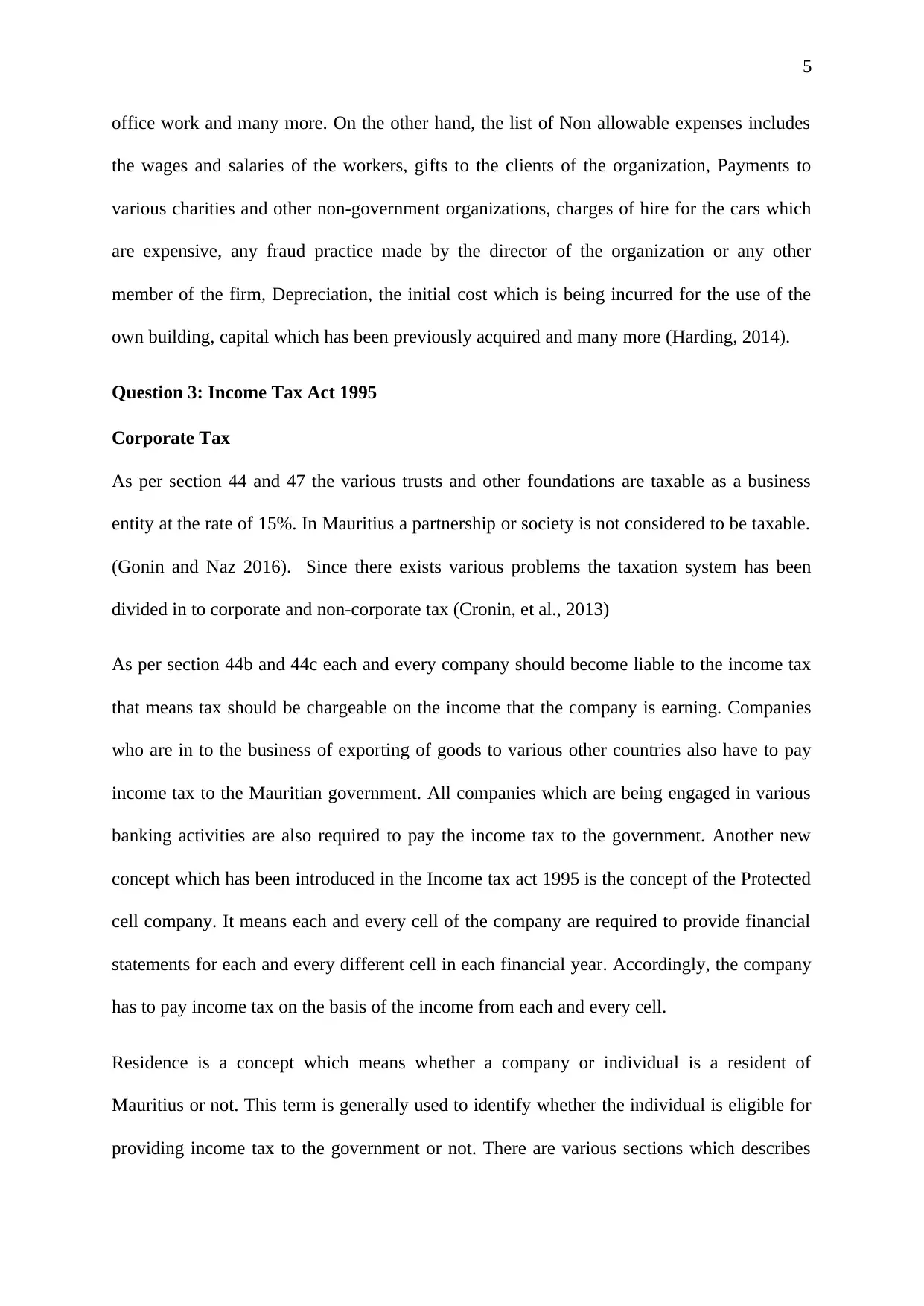
5
office work and many more. On the other hand, the list of Non allowable expenses includes
the wages and salaries of the workers, gifts to the clients of the organization, Payments to
various charities and other non-government organizations, charges of hire for the cars which
are expensive, any fraud practice made by the director of the organization or any other
member of the firm, Depreciation, the initial cost which is being incurred for the use of the
own building, capital which has been previously acquired and many more (Harding, 2014).
Question 3: Income Tax Act 1995
Corporate Tax
As per section 44 and 47 the various trusts and other foundations are taxable as a business
entity at the rate of 15%. In Mauritius a partnership or society is not considered to be taxable.
(Gonin and Naz 2016). Since there exists various problems the taxation system has been
divided in to corporate and non-corporate tax (Cronin, et al., 2013)
As per section 44b and 44c each and every company should become liable to the income tax
that means tax should be chargeable on the income that the company is earning. Companies
who are in to the business of exporting of goods to various other countries also have to pay
income tax to the Mauritian government. All companies which are being engaged in various
banking activities are also required to pay the income tax to the government. Another new
concept which has been introduced in the Income tax act 1995 is the concept of the Protected
cell company. It means each and every cell of the company are required to provide financial
statements for each and every different cell in each financial year. Accordingly, the company
has to pay income tax on the basis of the income from each and every cell.
Residence is a concept which means whether a company or individual is a resident of
Mauritius or not. This term is generally used to identify whether the individual is eligible for
providing income tax to the government or not. There are various sections which describes
office work and many more. On the other hand, the list of Non allowable expenses includes
the wages and salaries of the workers, gifts to the clients of the organization, Payments to
various charities and other non-government organizations, charges of hire for the cars which
are expensive, any fraud practice made by the director of the organization or any other
member of the firm, Depreciation, the initial cost which is being incurred for the use of the
own building, capital which has been previously acquired and many more (Harding, 2014).
Question 3: Income Tax Act 1995
Corporate Tax
As per section 44 and 47 the various trusts and other foundations are taxable as a business
entity at the rate of 15%. In Mauritius a partnership or society is not considered to be taxable.
(Gonin and Naz 2016). Since there exists various problems the taxation system has been
divided in to corporate and non-corporate tax (Cronin, et al., 2013)
As per section 44b and 44c each and every company should become liable to the income tax
that means tax should be chargeable on the income that the company is earning. Companies
who are in to the business of exporting of goods to various other countries also have to pay
income tax to the Mauritian government. All companies which are being engaged in various
banking activities are also required to pay the income tax to the government. Another new
concept which has been introduced in the Income tax act 1995 is the concept of the Protected
cell company. It means each and every cell of the company are required to provide financial
statements for each and every different cell in each financial year. Accordingly, the company
has to pay income tax on the basis of the income from each and every cell.
Residence is a concept which means whether a company or individual is a resident of
Mauritius or not. This term is generally used to identify whether the individual is eligible for
providing income tax to the government or not. There are various sections which describes
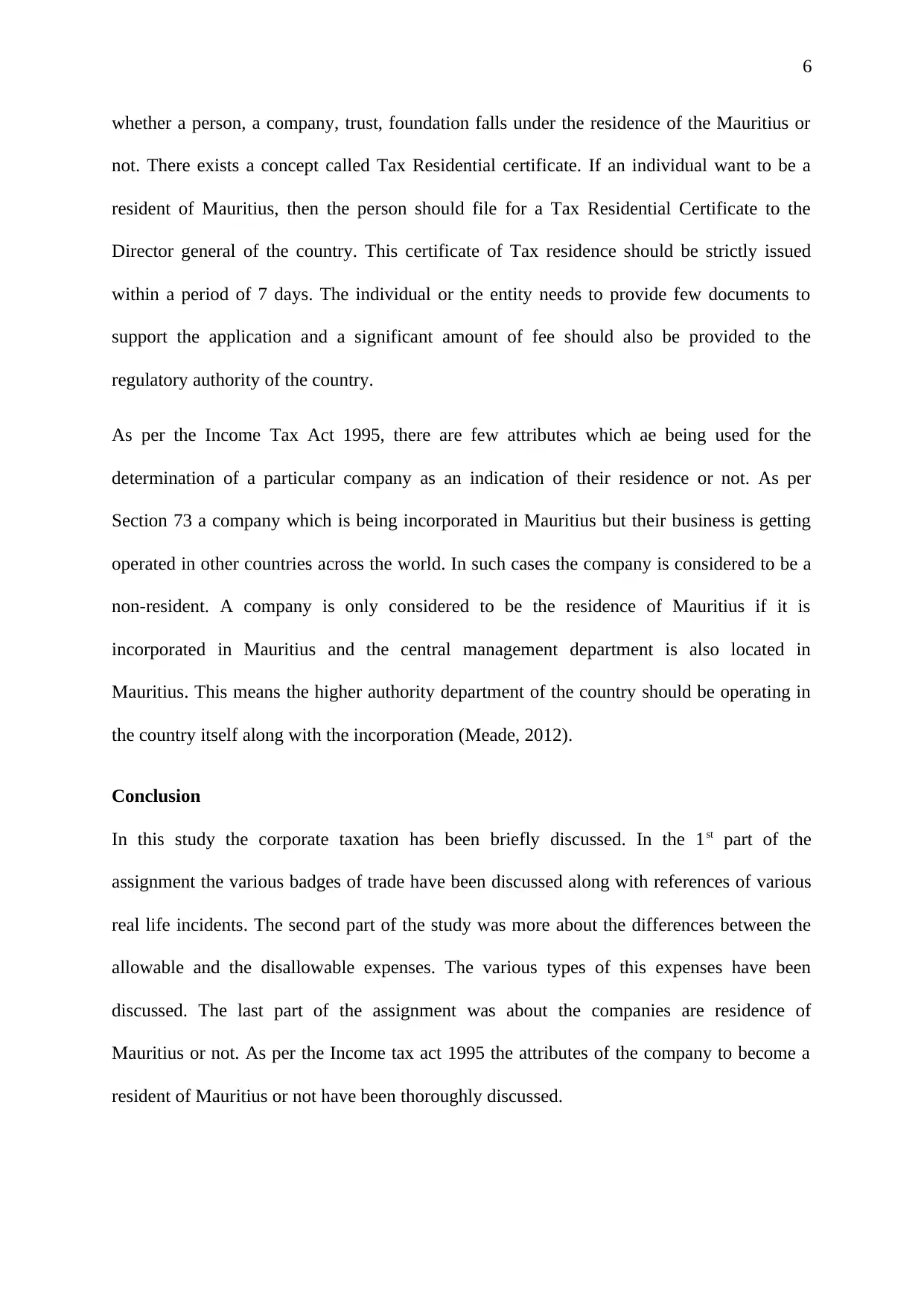
6
whether a person, a company, trust, foundation falls under the residence of the Mauritius or
not. There exists a concept called Tax Residential certificate. If an individual want to be a
resident of Mauritius, then the person should file for a Tax Residential Certificate to the
Director general of the country. This certificate of Tax residence should be strictly issued
within a period of 7 days. The individual or the entity needs to provide few documents to
support the application and a significant amount of fee should also be provided to the
regulatory authority of the country.
As per the Income Tax Act 1995, there are few attributes which ae being used for the
determination of a particular company as an indication of their residence or not. As per
Section 73 a company which is being incorporated in Mauritius but their business is getting
operated in other countries across the world. In such cases the company is considered to be a
non-resident. A company is only considered to be the residence of Mauritius if it is
incorporated in Mauritius and the central management department is also located in
Mauritius. This means the higher authority department of the country should be operating in
the country itself along with the incorporation (Meade, 2012).
Conclusion
In this study the corporate taxation has been briefly discussed. In the 1st part of the
assignment the various badges of trade have been discussed along with references of various
real life incidents. The second part of the study was more about the differences between the
allowable and the disallowable expenses. The various types of this expenses have been
discussed. The last part of the assignment was about the companies are residence of
Mauritius or not. As per the Income tax act 1995 the attributes of the company to become a
resident of Mauritius or not have been thoroughly discussed.
whether a person, a company, trust, foundation falls under the residence of the Mauritius or
not. There exists a concept called Tax Residential certificate. If an individual want to be a
resident of Mauritius, then the person should file for a Tax Residential Certificate to the
Director general of the country. This certificate of Tax residence should be strictly issued
within a period of 7 days. The individual or the entity needs to provide few documents to
support the application and a significant amount of fee should also be provided to the
regulatory authority of the country.
As per the Income Tax Act 1995, there are few attributes which ae being used for the
determination of a particular company as an indication of their residence or not. As per
Section 73 a company which is being incorporated in Mauritius but their business is getting
operated in other countries across the world. In such cases the company is considered to be a
non-resident. A company is only considered to be the residence of Mauritius if it is
incorporated in Mauritius and the central management department is also located in
Mauritius. This means the higher authority department of the country should be operating in
the country itself along with the incorporation (Meade, 2012).
Conclusion
In this study the corporate taxation has been briefly discussed. In the 1st part of the
assignment the various badges of trade have been discussed along with references of various
real life incidents. The second part of the study was more about the differences between the
allowable and the disallowable expenses. The various types of this expenses have been
discussed. The last part of the assignment was about the companies are residence of
Mauritius or not. As per the Income tax act 1995 the attributes of the company to become a
resident of Mauritius or not have been thoroughly discussed.
⊘ This is a preview!⊘
Do you want full access?
Subscribe today to unlock all pages.

Trusted by 1+ million students worldwide
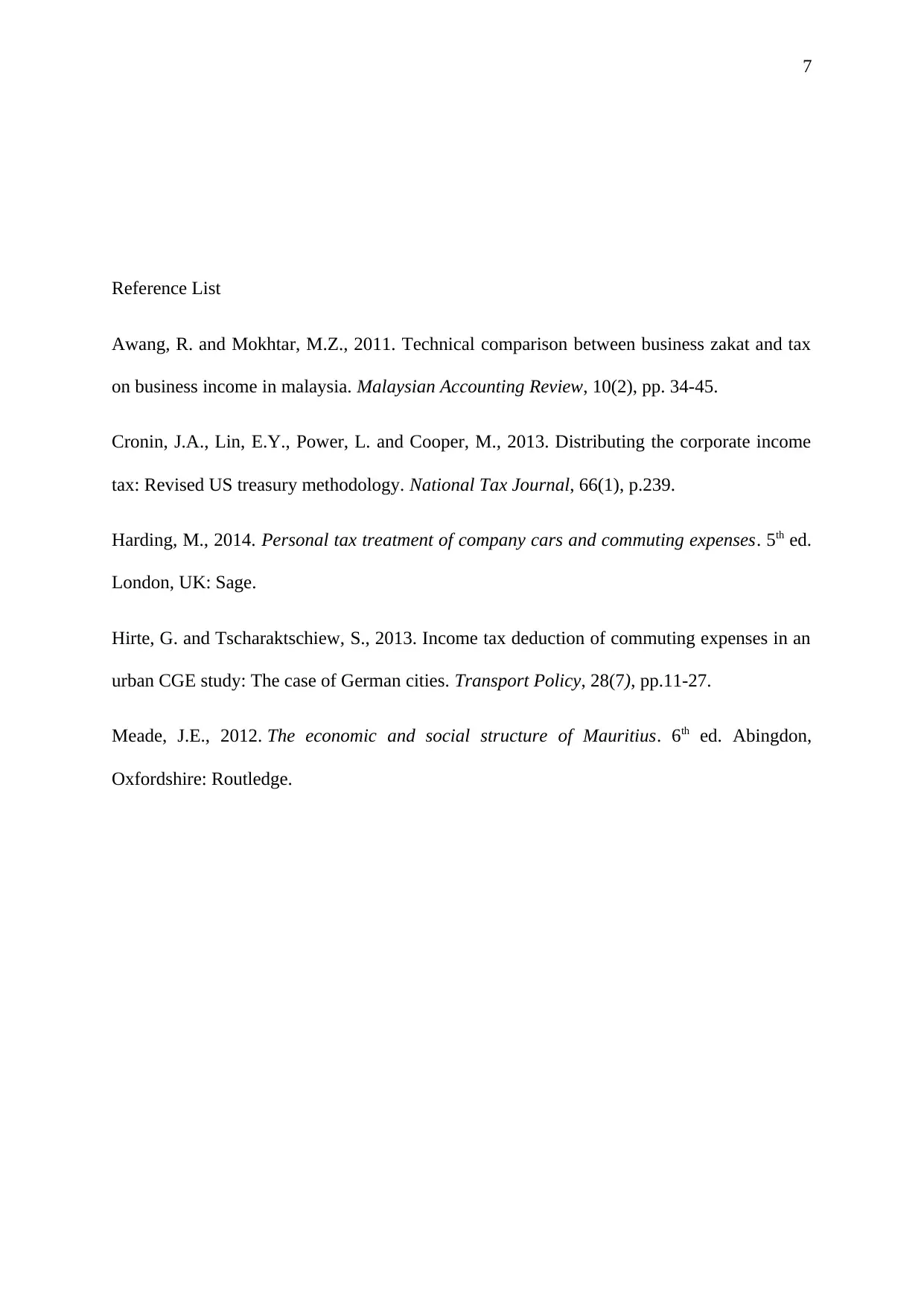
7
Reference List
Awang, R. and Mokhtar, M.Z., 2011. Technical comparison between business zakat and tax
on business income in malaysia. Malaysian Accounting Review, 10(2), pp. 34-45.
Cronin, J.A., Lin, E.Y., Power, L. and Cooper, M., 2013. Distributing the corporate income
tax: Revised US treasury methodology. National Tax Journal, 66(1), p.239.
Harding, M., 2014. Personal tax treatment of company cars and commuting expenses. 5th ed.
London, UK: Sage.
Hirte, G. and Tscharaktschiew, S., 2013. Income tax deduction of commuting expenses in an
urban CGE study: The case of German cities. Transport Policy, 28(7), pp.11-27.
Meade, J.E., 2012. The economic and social structure of Mauritius. 6th ed. Abingdon,
Oxfordshire: Routledge.
Reference List
Awang, R. and Mokhtar, M.Z., 2011. Technical comparison between business zakat and tax
on business income in malaysia. Malaysian Accounting Review, 10(2), pp. 34-45.
Cronin, J.A., Lin, E.Y., Power, L. and Cooper, M., 2013. Distributing the corporate income
tax: Revised US treasury methodology. National Tax Journal, 66(1), p.239.
Harding, M., 2014. Personal tax treatment of company cars and commuting expenses. 5th ed.
London, UK: Sage.
Hirte, G. and Tscharaktschiew, S., 2013. Income tax deduction of commuting expenses in an
urban CGE study: The case of German cities. Transport Policy, 28(7), pp.11-27.
Meade, J.E., 2012. The economic and social structure of Mauritius. 6th ed. Abingdon,
Oxfordshire: Routledge.
1 out of 7
Related Documents
Your All-in-One AI-Powered Toolkit for Academic Success.
+13062052269
info@desklib.com
Available 24*7 on WhatsApp / Email
![[object Object]](/_next/static/media/star-bottom.7253800d.svg)
Unlock your academic potential
Copyright © 2020–2025 A2Z Services. All Rights Reserved. Developed and managed by ZUCOL.





